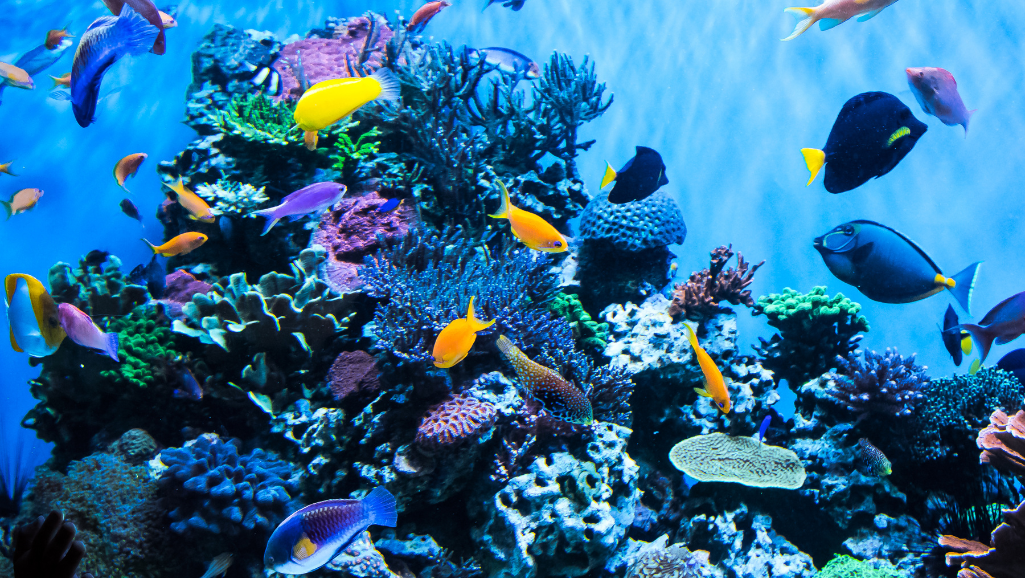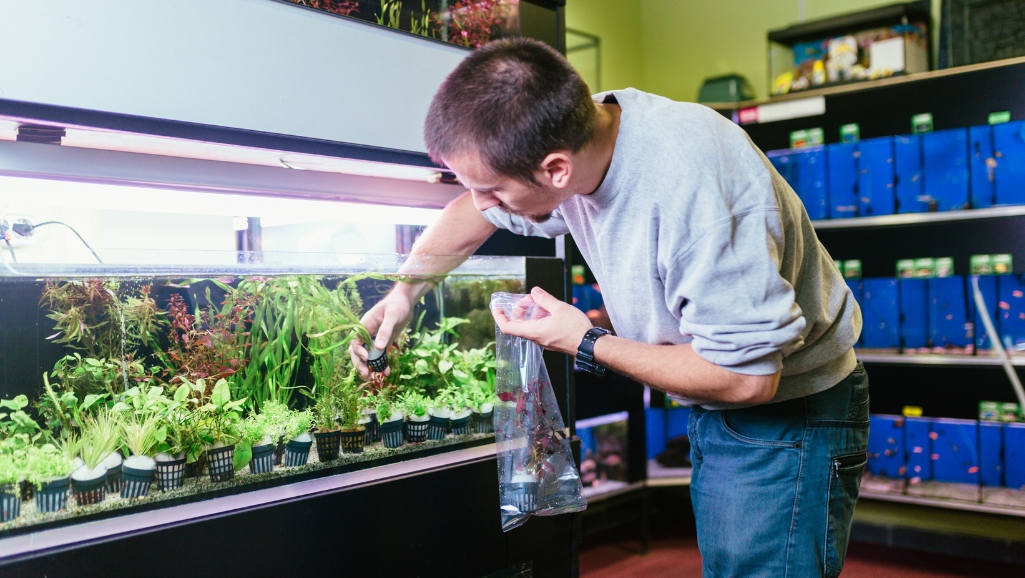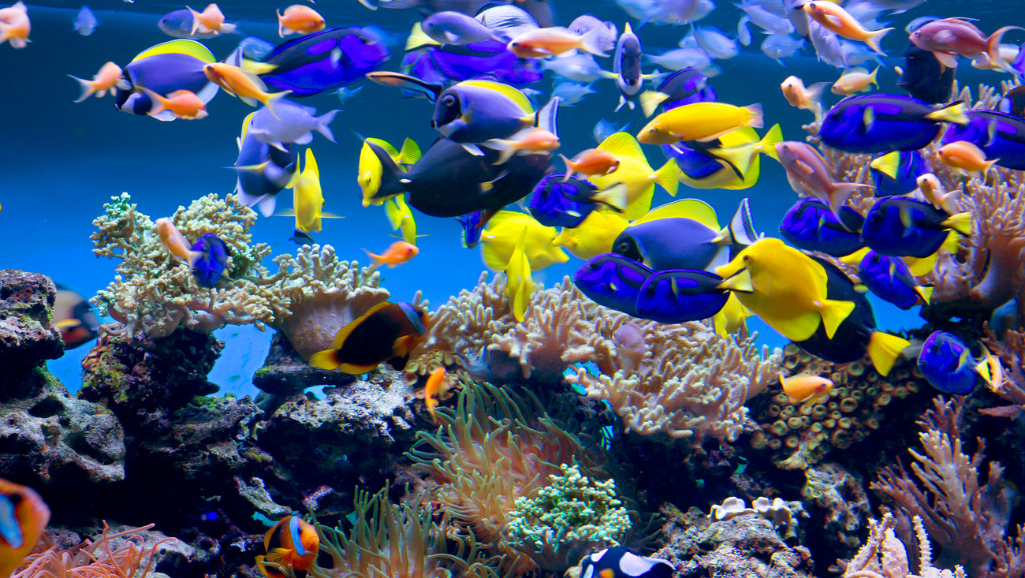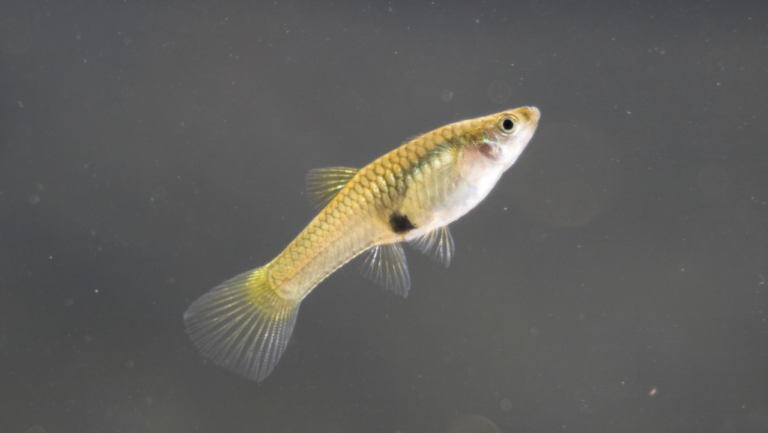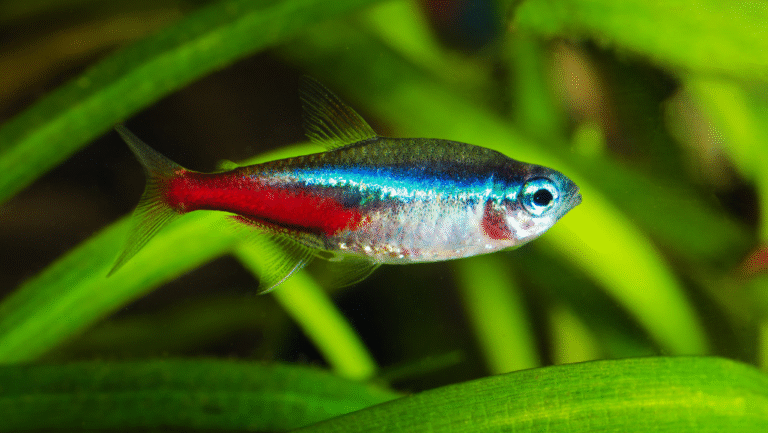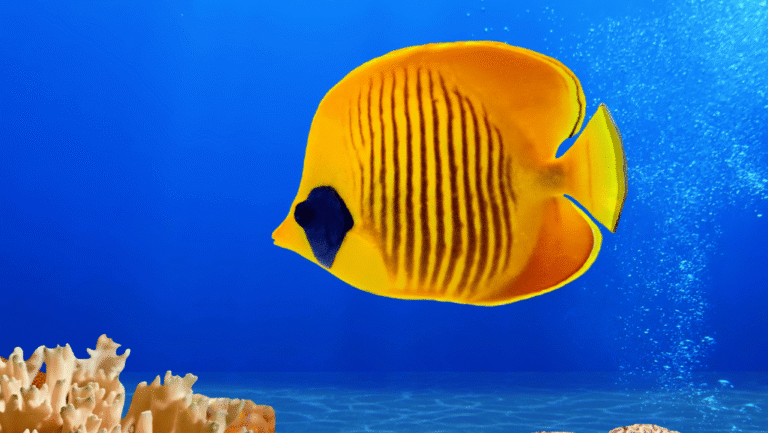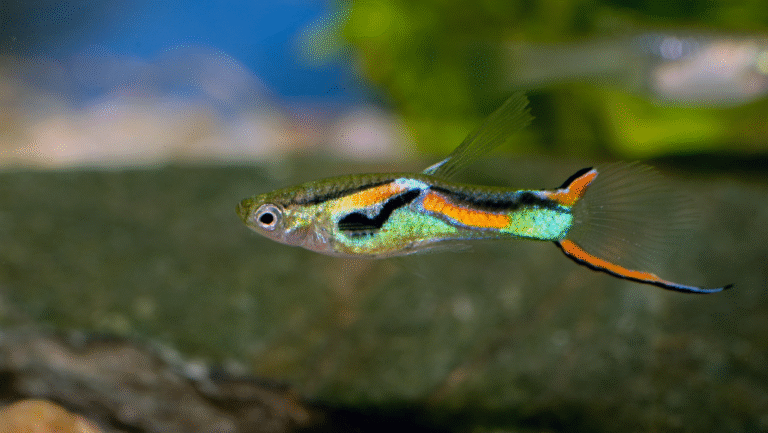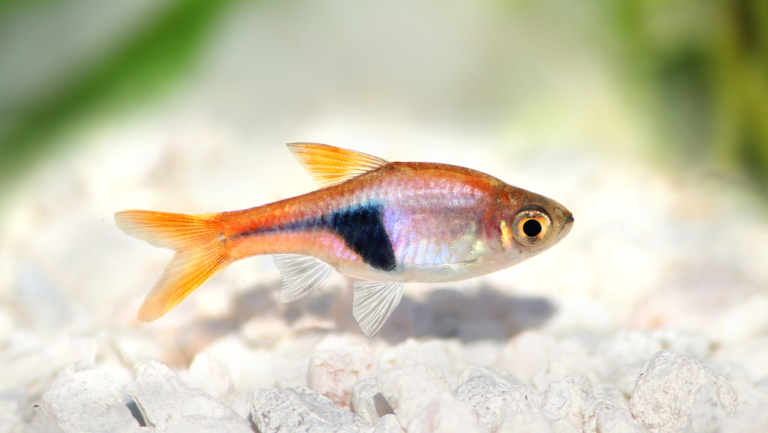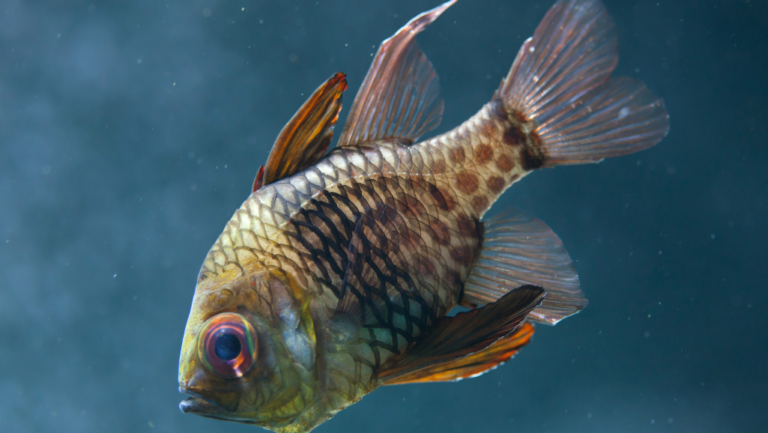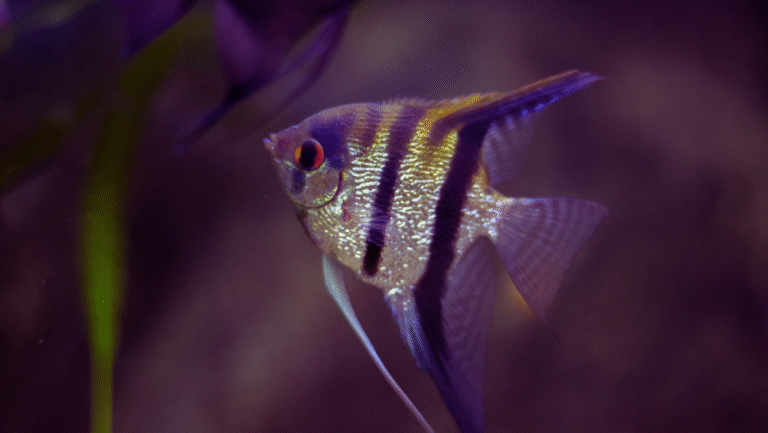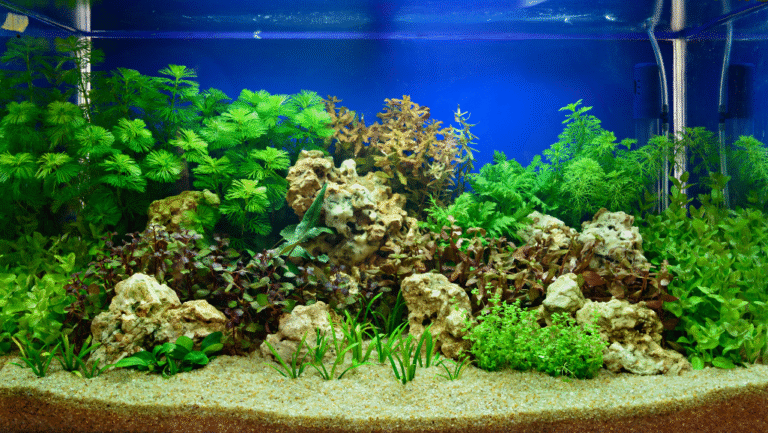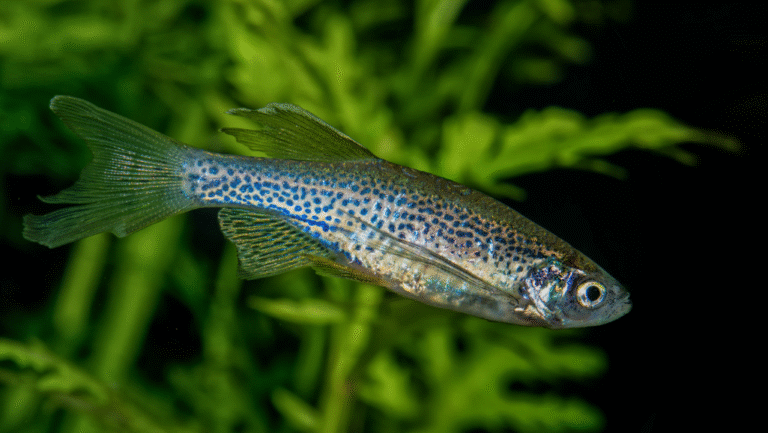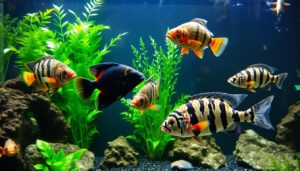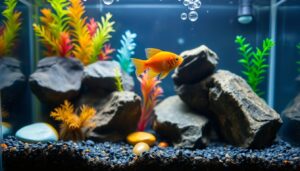Step into the calm and beauty of an aquatic paradise with aquarium tropical fish in your home. Each tank shows a world of color and life. You’ll see everything from elegant angelfish to fun clownfish, all living in their own underwater worlds.
Watching the African Chrysurus Angel or the Clown Trigger Fish is a treat. Fishkeeping is more than just a hobby; it makes any room look better and brings peace. It connects us to nature. Start your own underwater kingdom and enjoy the beauty of many colorful fish and the endless possibilities it offers.
Key Takeaways
- Embrace the serenity of an aquatic paradise with a home aquarium.
- Explore the vibrant diversity of aquarium tropical fish.
- Design a unique underwater landscape as a captivating focal point.
- Experience the therapeutic effects of a vibrantly populated tank.
- Discover the ease of creating your aquatic haven with guidance on live shipping for aquarium tropical fish.
- Learn about the basics of fishkeeping for a healthy, thriving aquatic environment.
Embracing the Art of Fishkeeping
Fishkeeping is more than just keeping an aquarium. It’s about creating a vibrant underwater world that adds beauty to your home and improves your wellbeing. Setting up the best aquarium setups for tropical fish requires attention to detail and knowledge of the tank’s ecosystem. This hobby combines beauty, biology, and science to create a peaceful space.
The Aesthetic Appeal of Home Aquariums
Adding freshwater aquarium fish to your home decor is not just about looks. It’s about connecting with nature. Aquarists use their creativity to design tanks that meet the needs of their fish and plants. This brings vibrant colors and calm movements to any room.
Create Your Underwater Landscape
Creating a tropical fish tank setup is a sign of dedication to nature. Using live plants, rocks, and substrate, aquarists build habitats that support fish health. This balance of function and beauty makes aquariums a science and an art.
The Therapeutic Benefits of Aquatic Diversity
Watching an aquarium filled with colorful fish is calming. It offers a break from daily stress. The gentle movement of plants and fish, along with the sound of water, creates a peaceful atmosphere.
In summary, fishkeeping is a way to express yourself and care for the environment. By choosing the right fish and managing their habitats, aquariums become living ecosystems. They bring beauty and joy to our lives.
The Vibrant World of Aquarium Tropical Fish
The charm of aquarium tropical fish draws in both new and seasoned fans. These vibrant waters are filled with a stunning variety of colorful fish species. Each fish adds its own color and behavior to the underwater scene. In Lakeland, Florida, Urban Tropical is a top spot for quality and care, raising some of the most beautiful tropical fish species for freshwater tanks.
Urban Tropical’s tanks light up the place, each a unique world full of freshwater tropical fish. You’ll see everything from the bright Red Wag Platies to the soft Ember Tetras. They focus on looks and health, aiming to create a natural home for these fish. Brittany Hollon, the operations officer, says they’re not just breeding fish. They’re building a place where fish can thrive naturally.
Learn about the top ten colorful fish that can turn any tank into a lively underwater world. Fish like the Cherry Barbs and Red Axelrodi Rasboras are not just beautiful. They also show interesting group behaviors, perfect for tanks that show off schooling.
| Fish Species | Preferred Environment | Coloration |
|---|---|---|
| Cherry Barb | Acidic Water | Vivid Red |
| Red Axelrodi Rasbora | Tightly Planted Tanks | Silver Body with Red Fins |
| Bloodfin Tetras | Tanks with Dense Plant Coverage | Bright Silver with Red Accents |
| Chili Rasbora | Densely Planted Tanks | Fiery Red |
| Ember Tetra | Well-Planted with Ample Swimming Space | Fiery Red |
This colorful mix of fish not only makes aquariums look great but also teaches us about their needs. Urban Tropical, through responsible breeding and care, is a key player in the community. They inspire and teach others on how to keep freshwater tropical fish sustainably.
Setting Up a Tropical Fish Tank: A Guide for Beginners
Starting a tropical fish tank is exciting for new hobbyists. With the right supplies, you can create a lively, healthy space. It brings the beauty of water life into your home.
Choosing the Right Equipment
First, pick the right tank size. It’s key for your beginner aquarium fish‘s health. Use a filter that changes the tank’s water 3-5 times an hour for clean water. A reliable heater keeps the water at 74-80 degrees Fahrenheit, perfect for most tropical fish.
Don’t forget the substrate. You can choose from gravel, sand, or plant substrate. It supports plants and helps filter the water. Lighting is also important, especially for live plants that need the right light to grow.
Balancing the Ecosystem
Setting up the ecosystem is crucial. Start with tank cycling to create good bacteria. This is key for cleaning the water. Add decorations and plants for beauty and to help fish feel safe.
Keeping the tank clean is essential. Use a siphon to clean the substrate and change 20-25% of the water monthly. Feed fish twice a day, but only as much as they can eat in a few minutes. This avoids pollution and keeps the water clean.
| Supply | Importance | Recommended Specs |
|---|---|---|
| Filter | Cleans and oxygenates water | Turnover rate of 3-5x tank volume per hour |
| Heater | Maintains optimal temperature | 74-80°F (23-27°C); 5W per gallon |
| Substrate | Supports plant growth and aids filtration | Aquarium gravel, sand, or plant substrate |
| Lighting | Essential for plant and fish health | Varies based on plant needs |
| Water conditioner | Removes harmful chemicals | Chloramine remover recommended |
For more tips on setting up a tropical fish tank, check out aquarium resources. They offer great advice and product suggestions. With care and patience, your tank will become a peaceful, beautiful part of your home.
Care and Maintenance for a Thriving Aquatic Environment
Starting a vibrant aquatic ecosystem needs science and hard work. To keep a tropical fish tank balanced, you must learn about aquarium fish maintenance. This effort goes beyond the initial setup, becoming a constant care process. It ensures your fish stay healthy and beautiful.
The key to a successful tropical fish care guide is watching water quality closely. You need to keep temperature, pH level, and ammonia in the right ranges. Also, regular tank cleaning is crucial. It removes harmful toxins and keeps the water clear.
- Weekly check-ups and adjustments of water pH (ideally between 6.8 to 7.8) and temperature (74-82ºF) to suit specific fish species.
- Regular water changes, about 10-25% per week, to reduce nitrate buildup and add trace elements.
- Monthly checks and cleaning of filters to keep water quality high.
- Feeding routines adjusted to once daily, matching the natural diet of the fish and avoiding excess nutrients.
- Adding compatible aquatic plants to beautify the habitat, help with nutrient cycling, and provide shelter.
Following a strict fish tank care routine helps your fish live longer and makes your tank look great. It’s about managing light to stop algae and choosing the right filter for your tank size. Every detail is important for a thriving aquatic environment.
In summary, a thriving aquarium comes from consistent care and a desire to learn about your ecosystem. By focusing on aquarium fish maintenance, you can create a healthy, beautiful space. It brings a piece of the underwater world into your home.
Start Your Adventure with Hardy Freshwater Tropical Fish
Starting your aquarium journey with tropical fish for beginners is rewarding. Hardy freshwater tropical fish are vibrant and easy to care for. They’re perfect for new aquarists.
Some tropical fish are great for beginners because they’re hardy and easy to care for. Betta Fish, Neon Tetras, and Corydoras Catfish are top picks. They do well in many conditions.
Betta Fish: A Colorful Solo Performer
Betta Fish are known for their bright colors and long fins. They’re easy to care for and make a beautiful centerpiece. They’re perfect for those starting with a simple yet elegant pet.
Neon Tetras: Dazzling Schooling Fish
Neon Tetras are mesmerizing with their shimmering colors and schooling behavior. They add brilliance to any tank. Keeping them in groups of six or more is best to see their stunning display.
Corydoras Catfish: The Clean-Up Crew
Corydoras Catfish are vital for keeping the tank clean. They eat leftovers and detritus from the bottom. This keeps the environment healthy and reduces cleaning for the aquarist. They’re a great choice for beginners.
Starting with these beginner-friendly fish is a great way to begin. It sets you up for success and builds confidence. These species make your aquarium journey fun and educational, sparking a lifelong passion for fishkeeping.
Tropical Fish Compatibility: Creating a Harmonious Community
To keep your aquarium peaceful and healthy, knowing about tropical fish compatibility is key. It’s not just about how pretty the fish are. Their behavior and needs must also match well.
Understanding Fish Temperaments
Every tropical fish has its own personality. Some are calm and get along with many other fish. Others might be aggressive or claim their territory. Knowing that Corydoras like to be in groups helps you pick fish that get along.
The Importance of Space and Hiding Spots
Setting up your tank right is crucial for tropical fish compatibility in aquariums. Fish need places to hide from stress, especially in tanks with many fish. Giving each fish its own space helps keep the tank peaceful.
| Fish | Compatibility | Considerations |
|---|---|---|
| Neon Tetras | Y (70%) | Prefers schooling in groups of six or more for vibrant display and social behavior |
| Corydoras Catfish | Y (70%) | Peaceful; thrives in group settings mimicking large schools found in nature |
| Cherry Barbs | C (20%) | Can display territorial behavior; males show brighter colors when stressed |
| Guppies | Y (70%) | Livebearers need varied diet and protection since they are often targeted by larger fish |
| Oto Cats | Y (70%) | Non-aggressive; requires specific water conditions to thrive |
| Dwarf Gouramis | N (10%) | Can be aggressive, particularly males during breeding season; requires careful pairing |
| Rummynose Tetras | Y (70%) | Best kept in large groups where they can exhibit tight schooling behavior |
Creating a peaceful aquarium is possible with the right knowledge. Use charts, respect each fish’s needs, and provide a good home. This way, all fish can live happily together. This not only makes fishkeeping more enjoyable but also keeps your aquarium healthy and lively.
The Delicate World of Tropical Fish Care and Feeding
Caring for tropical fish in an aquarium is a fun yet complex task. It needs a good understanding of tropical fish feeding habits and the right tropical fish food for each species. Each fish has its own diet needs to stay healthy and full of energy.
For example, Neon Tetras love high-quality flake foods and small granules. Fancy Guppies do well with a mix of live or frozen foods and varied diets. Knowing these details is key to caring for tropical fish in an aquarium. Also, keeping an eye on feeding and tank upkeep helps keep the environment clean and safe.
Here are some important tips for feeding and keeping your fish healthy:
- Feed small amounts of tropical fish food several times a day instead of one big meal. This is more natural and helps avoid overfeeding.
- Watch your fish while they eat to make sure they’re all getting food and look healthy.
- Change up their diet with quality flake food, frozen food, and the right pellets. This gives them a balanced diet that meets all their nutritional needs.
It’s also important to keep the water quality and tank conditions right:
| Fish Species | Group Size | Tank Conditions | Feeding Frequency |
|---|---|---|---|
| Neon Tetra | 6+ | Minimum 10 gallons | 2-3 times/day |
| Fancy Guppy | Small groups | 15 gallons with varied plants | 2 times/day |
| Black Skirt Tetra | 6+ | Minimum 10 gallons | 1-2 times/day |
| Zebra Danio | 5+ | 15 gallons | Twice daily |
| Otocinclus | 6+ | 20 gallons with algae | Once a day |
Keeping the aquarium at the right temperature and clean is as important as their diet. Make sure the water is around 78°F for most tropical fish. Also, change about 25% of the tank water every two weeks to keep the environment perfect.
Being well-informed and dedicated to tropical fish feeding habits and care is essential. With the right practices, you can ensure your colorful fish live a long and happy life in their well-kept home.
Encountering the Exotic: Rare and Unusual Species
For those who dive into exotic aquarium fish, saltwater and tropical fish open a world of beauty. These species add diversity and excitement to any aquarium. They make the underwater world more vibrant and interesting.
Saltwater aquarium fish create stunning ecosystems. Fish like tangs and angelfish add color and energy. They also play a key role in keeping the aquarium healthy.
The Allure of Saltwater Aquarium Fish
Saltwater aquarium fish fascinate both new and seasoned aquarists. Their vibrant colors and unique behaviors make them a top choice. But, they need special care, making them a rewarding yet challenging hobby.
Wolf Fish: For Experienced Aquarists Only
The Wolf Fish is for the most seasoned aquarists. They are known for their striking looks and size. These fish need large tanks, specific water, and a diet that matches their wild nature.
Exploring exotic tropical fish teaches us about ecological balance and fishkeeping duties. It’s a journey of learning about their needs and habitats. This experience deepens our understanding of the aquatic world.
While it’s a challenging hobby, it’s also incredibly rewarding. It expands our aquariums into global biodiversity, bringing beauty and a reminder of nature’s complexity into our homes.
Experience Aquatic Wonders at Destinations Like the Austin Aquarium
Start your journey at the Austin Aquarium. Here, you’ll see the beauty of aquatic life up close. The aquarium has a 12,000-gallon main exhibit filled with fish and marine creatures. It’s more than a place to see pets; it’s a place for fun and learning about marine life.
Engaging with Interactive Experiences
At the aquarium, you can touch small sharks, rays, and other sea animals in the touch tank. There are Sea Lion Shows and Shark Encounters for everyone. You can even feed tropical fish and play in the Play and Learn area. It’s great for families who want to dive into the underwater world.
Educational Programs for Conservation Awareness
The Austin Aquarium is all about teaching people about marine life. They offer workshops and activities to learn about conservation. By watching dive and feed shows, you learn about the importance of keeping these environments healthy.
| Feature | Details |
|---|---|
| Main Exhibit Size | 12,000 gallons |
| Species Housed | Over 50, including exotic reptiles |
| Interactive Experiences | Touch tanks, Sea Lion Show, Shark Encounter |
| Educational Opportunities | Workshops, dive shows, conservation programs |
| Operating Hours | Mon-Thur, Sun: 10 AM – 7 PM Fri-Sat: 10 AM – 8 PM |
| Location | 13530 US-183 Hwy #101, Austin, TX 78750, USA |
| Contact Info | +15122225586, Website |
Going to the Austin Aquarium is more than a trip. It’s a chance to learn and care about our planet’s underwater world.
Conclusion
The world of tropical fishkeeping is a journey filled with wonder. It starts with setting up a tropical fish tank and learning to keep it healthy. We discover the joy of introducing new fish species and the need for a balanced ecosystem.
Watching fish can be calming, just like studies show. Our own experiences show how peaceful it is to have a small piece of nature at home.
Keeping a fish tank healthy means checking the water often. We must watch for changes in ammonia, pH, and nitrate levels. This care keeps our fish safe and teaches us about their ecosystems.
Yes, fish tanks have an environmental impact. But a well-kept tank is small compared to other pets. To be green, we can choose low-energy equipment and use resources wisely.
Let’s enjoy the beauty of our fish tanks while caring for our planet. By doing so, we ensure our tanks and our values go hand in hand.
